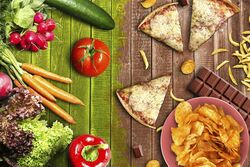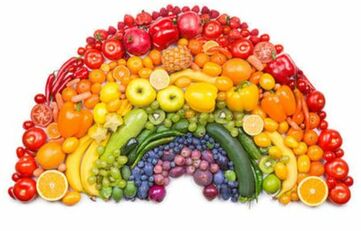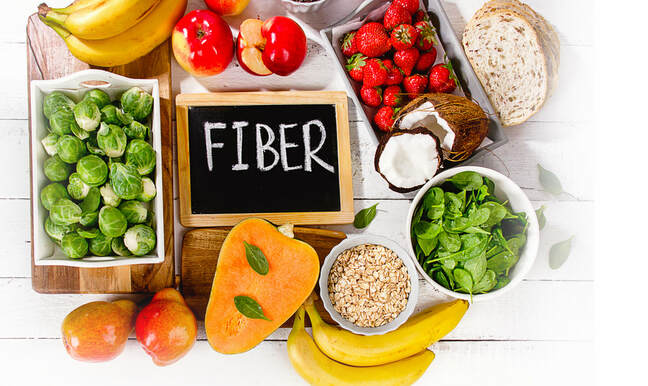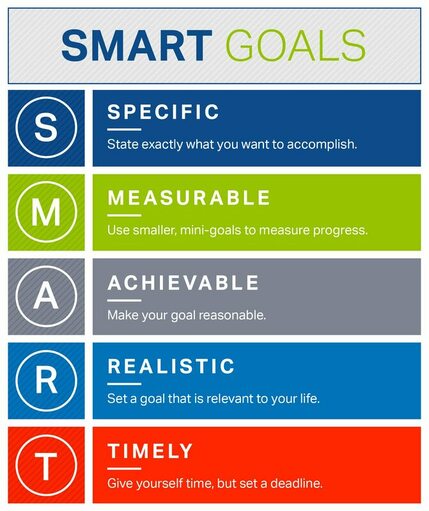|
We live in a day and age where we are inundated daily with all sorts of media promoting health diets, weight loss strategies, juice cleanses, foods to avoid, foods to restrict, foods to eat every day...the list goes on and on. While some of these posts/articles/stories are backed in science, many are not. All too often popular media exploits a phenomenon that had limited scientific evidence to support it and next thing you know we're all drinking celery juice on the daily. The fact of the matter is, if there was ONE perfect diet that worked for everyone, we'd all be eating it and we'd all be in perfect health. But we are all a unique blend of genetics, experiences, preferences, goals and ambitions. As such, our nutritional needs are different too. However there are some general guidelines to help you work good nutrition into your lifestyle. 1. Eat the rainbowWhen I teach youth nutrition classes for any age group this is the #1 thing I make sure they leave the room knowing. Fruits and veggies contain micronutrients (vitamins and minerals) that are SO important to a variety of bodily functions. Immune system, gut function, metabolism, heart rate, memory and concentration, bone maintenance, hormone regulation, you name it, there’s probably a vitamin or mineral involved in the process. Differently colored fruits and vegetables contain different vitamins and minerals, which why its so important to eat a variety to ensure you are getting ALL of the micronutrients you need. For all of their nutritious goodness fruits and veggies tend to be lower in calories than most other food groups. Which means you can eat A LOT of them- half your plate to be exact. According to the USDA adults should eat 5 combined servings of fruits and vegetables daily, however according to a CDC report in 2017, only 1 in 10 Americans are meeting that goal (1). So next time you’re looking for a tasty snack to fill you up grab a piece of fruit or some veggies and dip and get those micros in! 2. Fill up on fiberDietitians tend to cringe when we hear clients tell us they’re on a low-carb diet. The reason for this is that not all carbs are created equal, and while low-carb diets have been shown to be effective in aiding with weight-loss, they also put you at risk of missing out on essential nutrients like fiber. Fiber is a naturally occurring carbohydrate found in plants: primarily fruits, vegetables and whole grains. Our bodies cannot absorb fiber and as such it does not become glucose (sugar) in our blood. However, fiber still has a crucial role in our overall health. It has been shown to delay GI transit time making you feel fuller longer and less likely to over indulge (2). Fiber also helps slow digestion of simpler carbs, which can help stabilize blood sugar levels by preventing spikes and crashes (3). Fiber is also essential for maintaining gut health. As undigested fiber makes its way to the colon, it serves as a fuel source for our millions of gut bacteria, which have been shown to play a role in immune function, weight maintenance and hormone balance (4). Diets lacking in fiber have been associated with increased risk of heart disease and certain types of cancers. The CDC recommends consuming at least 25-30 grams of fiber per day for adults, which conveniently measures out to about 5 servings of fruits and veggies per day (see what I did there? #eatyourveggies). 3. Supplements should be just that All too often I see people relying on supplements for their nutrition rather than real food. Good nutrition is so much more than just hitting your calorie or macro goals (see point #5). Supplements should only be taken/consumed when you aren’t able to reach your nutrient goals with food alone. This can happen in situations where there are digestive disorders, food intolerances or increased needs (i.e. post-surgery, certain injuries, etc.). 4. Trend toward whole foodsJust like carbs, not all foods are created equal. Americans have done a wonderful job of finding cheap and efficient ways of stripping raw foods of their nutrients and packaging it into calorie/fat/sugar laden products. Technically, a processed food is any food that has undergone any alteration from its natural state. So even chopping and cooking veggies is technically a form of processing. However, when dietitians refer to “processed foods” vs. “whole foods,” we are generally referring to foods that come in packages vs. those that do not. Generally speaking, the more processing a food has undergone, the less nutritious it is. Furthermore, research has shown that when you eat whole foods you actually burn up to 50% more calories than eating a processed equivalent (5). This is because your digestive system has to work harder to harness the nutrients in whole foods. Processed foods are typically stripped down to make nutrients (good and bad) more readily available. Finally, whole/unprocessed foods are also less likely to contain additives. To be contained in food products, food additives have to be considered safe by the FDA, however some have been shown to promote inflammation and trigger allergic reactions (6). 5. Good nutrition is more than just the numbers This one might surprise you coming from someone who does at least 7 calculations per client. Here’s the thing: there are lots of elaborate eating plans out there. Some specify calories, some specify macros, others take it a step further and tell you when to eat what. The simple fact of the matter is that good nutrition is much more complicated than any eating plan can break down. In my practice, I find that my clients tend to be most hung up on two sets of numbers: their calories and their macros (i.e. carbs, fat and protein). Calories are in all foods and provide our bodies with energy. The more calories, the more energy that food provides. Macronutrients, or “macros” are nutrients in foods that provide calories. These include protein, carbohydrates and fat and are found in a wide variety of foods. They are referred to as macronutrients because you body needs them in large, or “macro,” quantities. As such, they build up the majority of our diet. Each macro is metabolized by a different pathway and used differently to fuel the body. All three are important components to a healthy, well balanced diet, however what most people don’t realize is that your body is readily able to convert between them depending on it’s needs. As such, macro ratios are far less important than where those macros are coming from. Because our bodies can convert between macronutrients, an important consideration for a healthy diet is making sure you’re getting a good blend of micronutrients (i.e. vitamins and minerals). Micronutrients as you may have guessed are nutrients that our bodies only need in small quantities, but that is not to say that they do not have a big impact on our overall health. Micronutrients such as antioxidants and phytochemicals are essential in supporting immune health, and chromium has been shown to help improve glucose control in people with type 2 diabetes (7). Micronutrients are found in all foods, so the key to ensuring you are getting all that you need is eating a balanced diet (for more info go to www.choosemyplate.gov). Beyond the nutrient composition of your meals, the “calories-in, calories-out” model of nutrition therapy is still not an exact science. For starters, it is very difficult to accurately assess metabolic rate. Our metabolic rate is how quickly our body burns energy. It will increase and decrease hundreds of times per day depending on our activity and countless other factors such as what we ate, how we slept, if we’re stressed, etc. While tools like the Bod Pod have helped practitioners by providing accurate measurements of metabolic rate, they are still only a snapshot of a moment in time, and do not necessarily reflect what is going on continuously throughout our day. Additionally, tracking the “calories-in” can also be both laborious and inaccurate. Even with tools like nutrition labels and portion sizes, most people have a hard time estimating how much they’re eating accurately. Combine this with the previous note that our bodies truly are different on different days, and it’s extremely difficult to build a “one-size-fits-all” model of nutrition. Your nutrition is as unique as YOU!These guidelines serve as a great starting point in developing a nutrition and eating plan that is right for you. However assessing your individual needs, and showing you how to work them into the lifestyle you want to live takes the expertise of a Registered Dietitian. As dietitians, we're trained to work with YOU. YOUR genetics, YOUR food preferences, YOUR cooking abilities, YOUR budget and YOUR goals. We can design a healthy eating plan for anyone because we take the time to get to know you as an individual and come up with a plan that's just right for you. So what are you waiting for?? Book your appointment today! References:1. https://www.cdc.gov/media/releases/2017/p1116-fruit-vegetable-consumption.html
2. https://www.mayoclinic.org/healthy-lifestyle/weight-loss/in-depth/weight-loss/art-20044318 3. https://www.joslin.org/info/how_does_fiber_affect_blood_glucose_levels.html 4. Slavin, J. (2013). Fiber and Prebiotics: Mechanisms and Health Benefits. Nutrients, 5(4). 1417-1435. 5. Barr, S. and Wright, J. (2010). Postprandial energy expenditure in whole-food and processed-food meals: Implications for daily energy expenditure. Food and Nutrition Research, 54, 5144. 6. Lemer, A. and Matthias, T. (2015). Changes in intestinal tight junction permeability associated with industrial food additives explain the rising incidence of autoimmune disease. Autoimmunity Reviews, 14(6). 479-489. 7. Costello, R., Dwyer, J. and Bailey, R. (2016). Chromium supplements for glycemic control in type 2 diabetes: limited evidences of effectiveness. Nutrition Reviews, 74(7) 455-468.
5 Comments
Ah here it is again, that time of year when the holidays end and the self-deprecation begins. All of the weeks of stress, decadent food and seemingly endless parties have finally come to a close and it’s time to get back to life as usual. It is also a time for new beginnings, reflection and with any luck, a newfound commitment to health and wellness. The problem? We tend to bite off more than we can chew, and as a result burn ourselves out. The key to sustainable changes is consistency. That does NOT mean being perfect every day. It DOES mean showing up to meet your goals more often than not. Here are my 5 tips to help you set realistic resolutions (and keep them!) in the new year! 1. Set Realistic GoalsIf you are a veteran of corporate America, you’ve likely heart of SMART goals. Smart is an acronym used for goal writing that helps ensure that said goals are both rational and accountable. The acronym SMART is derived from 5 characteristics: specific, measurable, attainable, realistic and time-bound. Research has shown that SMART goals are both effective, and efficient1 however most of us don’t think to use them when looking to personal goals. SMART goals can be beneficial for goals of any kind because they help to define and refine your intentions to help set you up for success. So let’s look at an example- a common resolution I hear from clients is they want to eat more healthfully in the new year. Great intention! But where is the specificity? What does a “healthful” diet look like for you? What are some realistic changes that you can make and stick to? This is where smart goals come in handy! -Get specific First, identify the behaviors you want to change or adopt. Let’s say for example you eat out frequently and know that you don’t always choose “healthy” options when you do. Next, identify the barriers to changing that behavior. Why did you develop the habit in the first place? Or why has changing it been something that’s hard for you to stick to? Be honest here. More often than not people know what to do. For our eating out example, this client likely knows that if they cooked more meals at home they would have more control over what they are eating and would be able to choose more healthful options. However knowing is only half the battle. Lets say this person also has a hectic job and doesn’t have time to cook. With just this first step our client has already shifted their goal from “eat more healthfully” to “find a way to eat out less and cook more frequently.” Now THAT is a goal I can work with! -Make it measureable, attainable and realistic Now that we have a better idea of what our client’s goal really looks like, let’s find a way to define what that will look like for them. If they are eating out 5 days per week, they are likely going to have a hard time pulling a complete 180 and cooking every night. So instead start with small, attainable steps, such as looking up a healthy recipe to prepare, going to the grocery store to purchase foods for that recipe, making a point to carve out time in your schedule to meal prep, etc. All of these steps may seem small, but taken together they are more likely to lead you to your goal because they are manageable. Remember, any step in the right direction is a step worth taking! -Set a timeline Rome wasn’t built in a day. Reaching meaningful goals takes time. So once you’ve got your goals in a format that is specific, measurable, attainable and realistic, think about how long it will take you to achieve those benchmarks. This can be as simple as setting a date for reaching your goal weight, or as with our client who wants to eat out less, can contain a series of progressive steps. For example, he or she may want to start by cooking one meal per week and work up to cooking 2-3 nights per week by the end of two months. 2. “A goal without a plan is just a wish” – Antoine de Saint-ExuperyOnce you’ve identified your SMART goals, it’s time to put them into action! One of the things I love about SMART goals is that they lend themselves so easily to making a roadmap, or plan, for success. By identifying your SMART goals you’ve identified what you want to accomplish, now its time for the how. This will look different for each person and each goal. For example if your goal is to complete a marathon by the end of the year, working with a training group, following a training regimen and joining an online support group might be steps you take to help keep you on track throughout the year. If your goal is to eat healthier, perhaps setting a calorie goal, keeping a food log and making a weekly meal plan are things you can do to help ensure your success. Whatever your goals may be, find a plan of attack that works for you and don’t be afraid to revisit the plan if you feel as though it is not working to help get you to your goals. Sometimes even the best-laid plans don’t lead to success, it is ok to go back to the drawing board and come up with a new one! 3. Celebrate the "Little" VictoriesA common blunder I see clients make is the only set long-term goals. Which is worthwhile, however if you don’t allow yourself to celebrate the short-term milestones towards reaching those goals, it can often feel like you’re not accomplishing anything, which then of course crushes your motivation and can quickly become a reason you stop making progress. Say for example your goal is to lose 50 pounds within a year- that’s realistic, but if you are only measuring your success once per year it is going to feel pretty defeating. Start by setting small goals such as 4-5 pounds per month or 1-2 pounds per week. Only weigh yourself once per week/month and congratulate yourself when you successfully reach a goal. You can also set goals unrelated to weight loss such as learning to love your body, improving your relationship with food and increasing your physical activity. All of these are goals that will help with your long-term goal of weight loss, but they have more tangible results in the here and now to help keep you motivated and stay on track! 4. Expect to Make MistakesAnother huge mistake I see clients make is letting slip-ups derail their entire journey. If you were learning to play the guitar and you messed up a few notes while trying to learn the riff from “Hot for Teacher” would you call yourself a failure and give up? Probably not. That solo is HARD and there’s a reason why Van Halen is famous for it. But as with anything, practice makes perfect. So extend the compassion for yourself in learning a new skill to reaching your health and wellness goals. You’re going to make mistakes. I guarantee it. But the good news is life is not about the mistakes you make but how you respond to those mistakes. Progress not perfection! 5. Don't Deprive YourselfHave you ever noticed that the second you tell yourself you can’t do something, that something is suddenly the only thing you want to do? It gradually becomes all-consuming and before you know it you’ve caved and done whatever it was you weren’t supposed to do and are now filled with regret and shame. If you think about it, it’s a crazy little game we play with ourselves. When it comes to food, I’ve said it before and I’ll say it again- there is no such thing as “good” foods and “bad” foods. Any food can be incorporated into a healthy eating plan. The key is moderation and planning. If you enjoy a good wine night with your girlfriends, don’t deprive yourself of it just because you’re trying to lose weight. Go, enjoy your night and stick to 1 glass instead of 2 (or 3, or 4…). If you LOVE Oreos, don’t tell yourself you can’t have them. Buy them, but stash them in the back of the pantry where they aren’t easily reached. When you eat them, stick to 1-2, take them out of the package and put the package back in its hiding place before you can reach for more. Small indulgences on occasion will not derail your progress. However if you deprive yourself for week, then cave and binge eat whatever it is you’ve deprived yourself of, not only will you feel ashamed and defeated, you’re also more likely to reverse any progress that you’ve made. Good nutrition is a marathon, not a sprint. Enjoy the journey rather than seeking only the destination.  “Courage doesn’t happen when you have all the answers. It happens when you are ready to face the questions you have been avoiding your whole life.” – Shannon L. Alder And there ya have it folks. My tips to help you get and stay on track with your health and wellness goals in the new year! As always I am here as your ally to help you reach YOUR nutrition and wellness goals, if you need help with more specific planning feel free to book a consult with me (book online at nuyounutrition.com)! Happy New Year! Erin References:
1. Lawlor, K.B. and Hornyak, H.J. (2012). SMART Goals: How the application of SMART goals can contribute to the achievement of student learning outcomes. Developments in Business Stimulation and Experiential Learning, 39, 259- 267. |
Erin Casey, MS, RD, LDLet's be honest, most dietitians go into the field for one reason: we LOVE food. Check out my weekly posts for recipes, healthy eating tips and goal setting strategies to help you live your best and healthiest life! Archives
August 2022
Categories |




 RSS Feed
RSS Feed